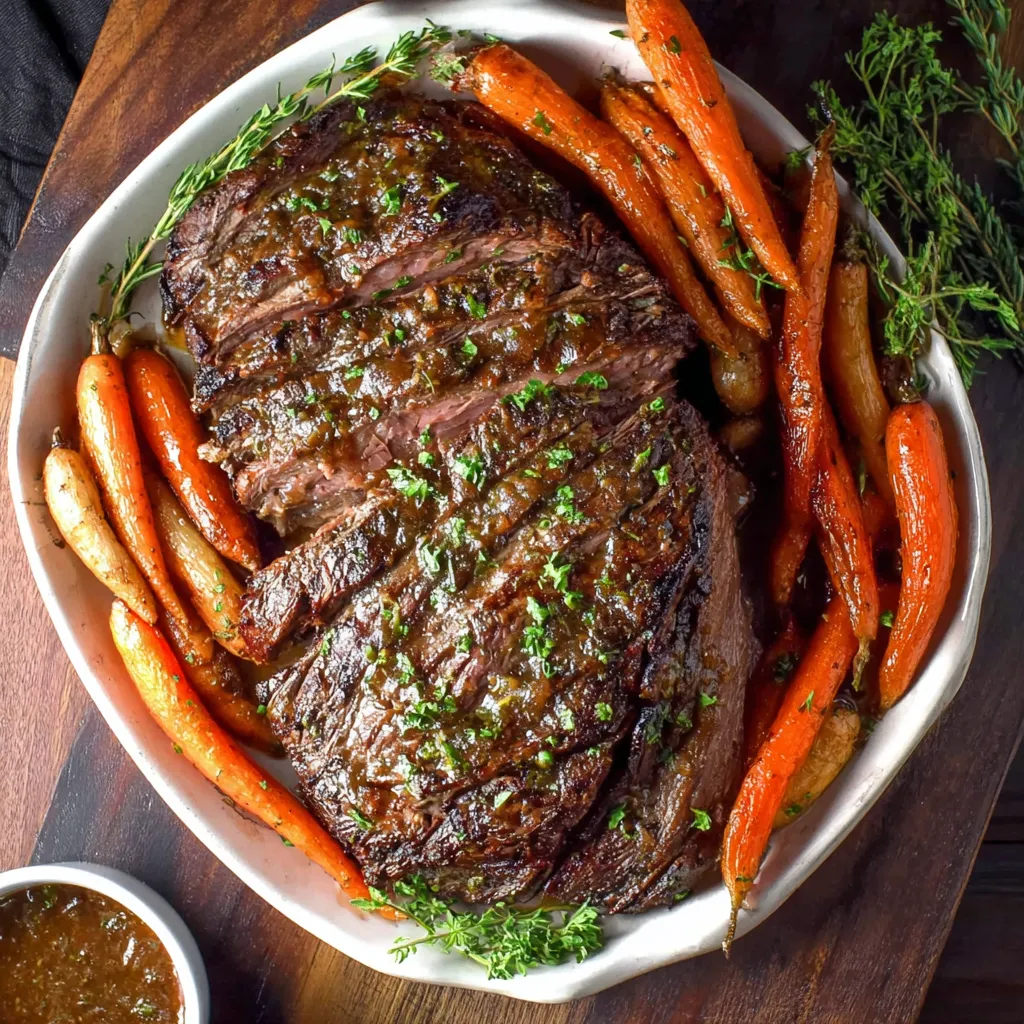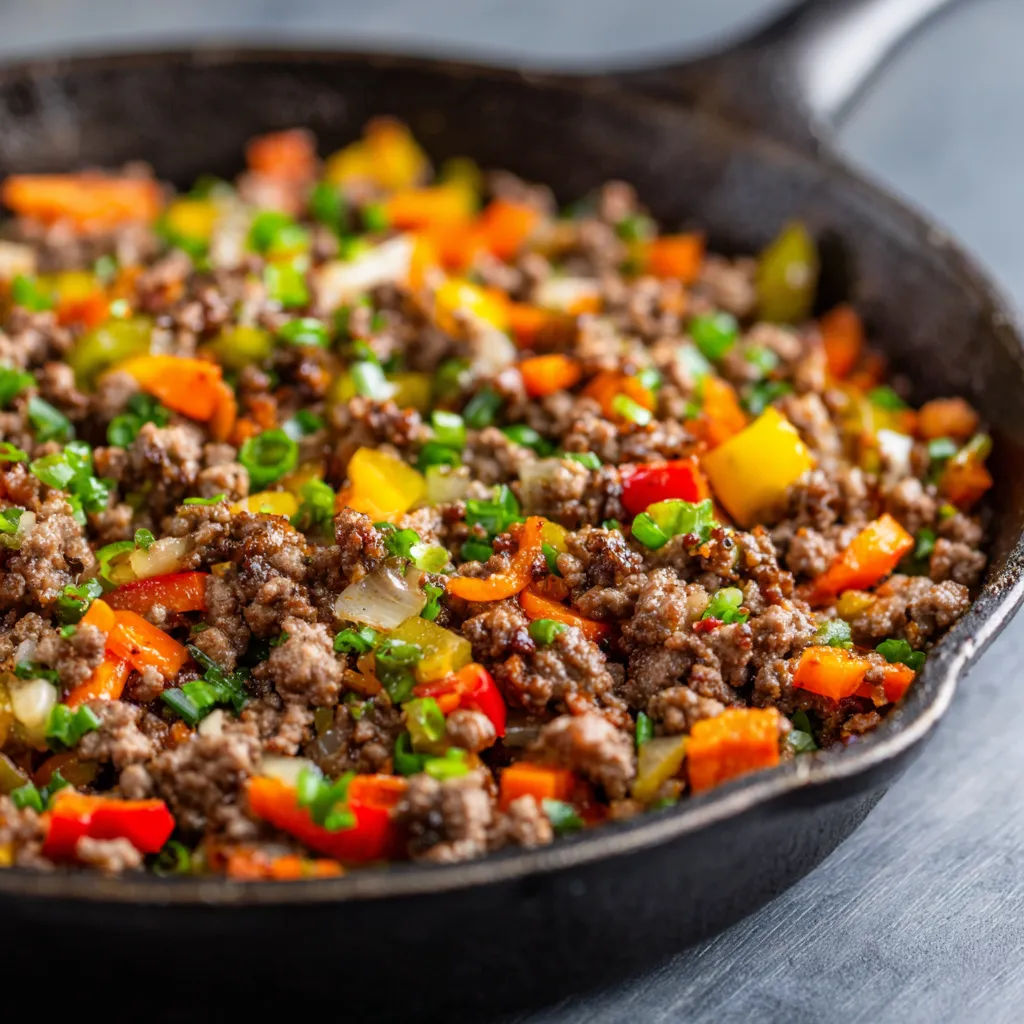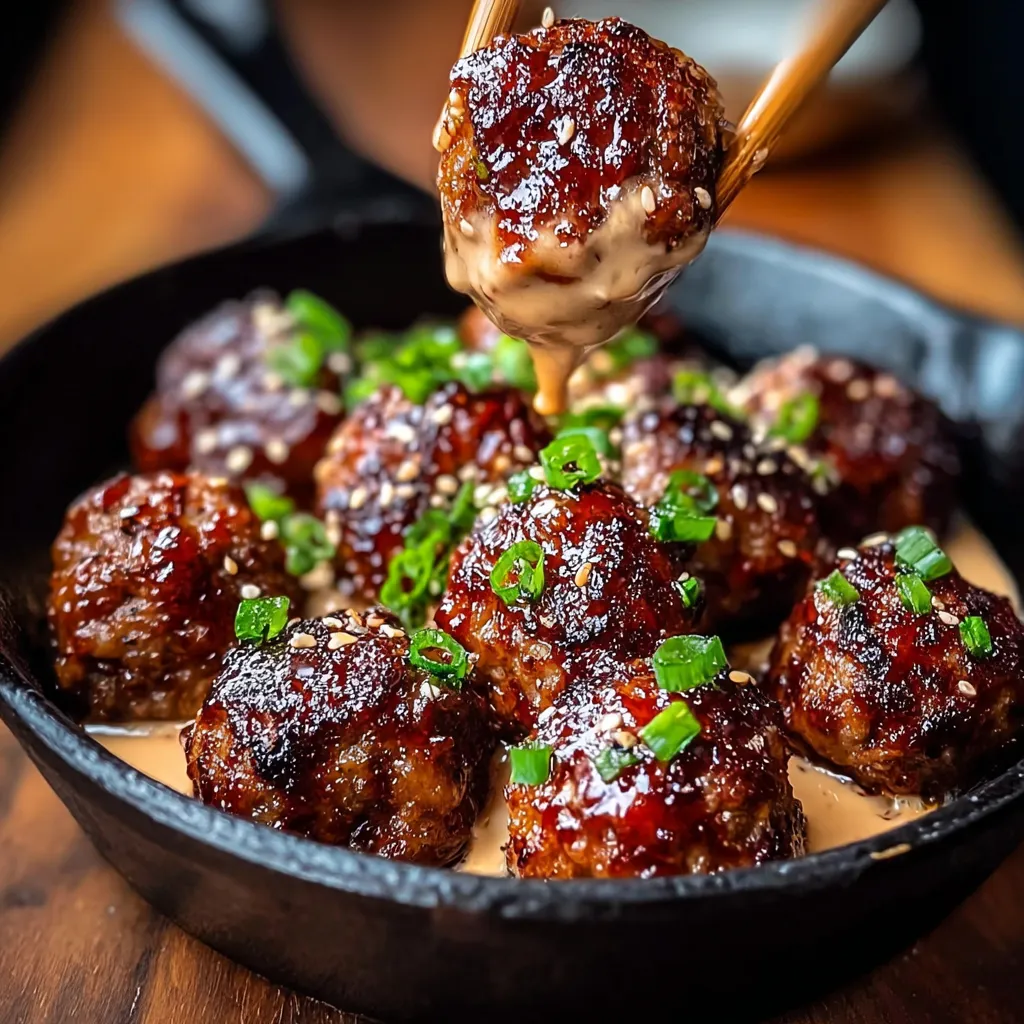Craving an Asian-inspired meal that’s both quick to prepare and bursting with flavor? Look no further than this delicious Korean Ground Beef Bowl! Ready in just 20 minutes, this savory and slightly sweet dish combines tender ground beef with a mouthwatering sauce featuring ginger, garlic, and sesame. Served over fluffy rice and topped with fresh veggies, it’s the perfect weeknight dinner solution when you need something fast but don’t want to sacrifice flavor.
When life gets hectic and time is short, having a go-to recipe that delivers restaurant-quality taste with minimal effort becomes invaluable. This Korean Ground Beef Bowl recipe has become a reader favorite for exactly that reason – it strikes the perfect balance between convenience and incredible flavor. Inspired by traditional Korean bulgogi but simplified for busy home cooks, this dish captures the essence of Korean cuisine with ingredients you likely already have in your pantry.
The magic of this Korean-inspired beef bowl lies in its versatility. Whether you’re cooking for picky eaters, meal prepping for the week ahead, or trying to impress dinner guests without spending hours in the kitchen, this recipe adapts beautifully to your needs. The combination of sweet, savory, and umami flavors creates a depth that belies the dish’s simple preparation, making it taste like you’ve spent far more time cooking than you actually have.
Why You’ll Love This Korean Ground Beef Bowl
- Ready in just 20 minutes – perfect for busy weeknights!
- Budget-friendly – uses affordable ground beef and pantry staples
- Family-approved – sweet and savory flavors kids and adults both love
- Meal-prep friendly – makes excellent leftovers
- Customizable – easily adapt with your favorite vegetables
- Healthier than takeout – control the ingredients and sodium levels
- No special equipment needed – just a skillet and basic kitchen tools
The Perfect Solution for Busy Home Cooks
In today’s fast-paced world, finding time to prepare nutritious, flavorful meals can feel like an impossible challenge. That’s where this Korean Ground Beef Bowl truly shines. Unlike many quick dinner options that sacrifice quality for convenience, this recipe delivers exceptional taste without demanding hours of your time. The combination of lean ground beef with aromatic ginger, garlic, and the unmistakable nuttiness of sesame oil creates a depth of flavor that rivals dishes requiring much more complex preparation.
What makes this Korean beef recipe particularly special is how it transforms everyday ingredients into something extraordinary. Ground beef, a staple in many households, becomes elevated with the addition of a few key Asian ingredients. The result is a dish that feels special enough for a weekend dinner but is simple enough for a Monday night when you’re running on empty after a long day.
A Healthier Alternative to Takeout
We’ve all experienced those evenings when ordering takeout seems like the only viable option. However, this quick Korean beef bowl provides a compelling alternative that’s not only faster than delivery but significantly healthier. By preparing this dish at home, you control exactly what goes into your meal – meaning you can adjust the sodium, sugar, and fat content to align with your dietary preferences.
Most restaurant versions of similar dishes contain hidden sugars, excessive sodium, and sometimes MSG. This homemade version allows you to enjoy all the flavors of your favorite Asian restaurant while using high-quality ingredients and appropriate portion sizes. It’s a win-win for both your taste buds and your wellbeing.
Ingredients for Korean Ground Beef Bowl
For the Beef Mixture:
- 1 pound lean ground beef (93% lean recommended)
- 3 cloves garlic, minced
- 1 tablespoon fresh ginger, grated
- 1/4 cup low-sodium soy sauce
- 3 tablespoons brown sugar
- 1 tablespoon sesame oil
- 1/2 teaspoon red pepper flakes (adjust to taste)
- 3 green onions, sliced (white and green parts separated)
- 1 tablespoon vegetable oil (for cooking)
- 1 teaspoon rice vinegar (optional, for brightness)
- 1/4 teaspoon black pepper
For Serving:
- 3 cups cooked rice (white or brown)
- 1 cucumber, thinly sliced
- 1 carrot, julienned or grated
- 1 cup mixed greens or shredded cabbage
- 1 avocado, sliced (optional)
- Sesame seeds for garnish
- Additional sliced green onions for garnish
- Kimchi (optional, for authentic Korean flavor)
- Gochujang sauce (optional, for extra spice)
Understanding the Key Ingredients
The beauty of this Korean beef bowl recipe lies in its straightforward ingredient list that delivers complex flavors. Let’s take a closer look at what makes each component essential:
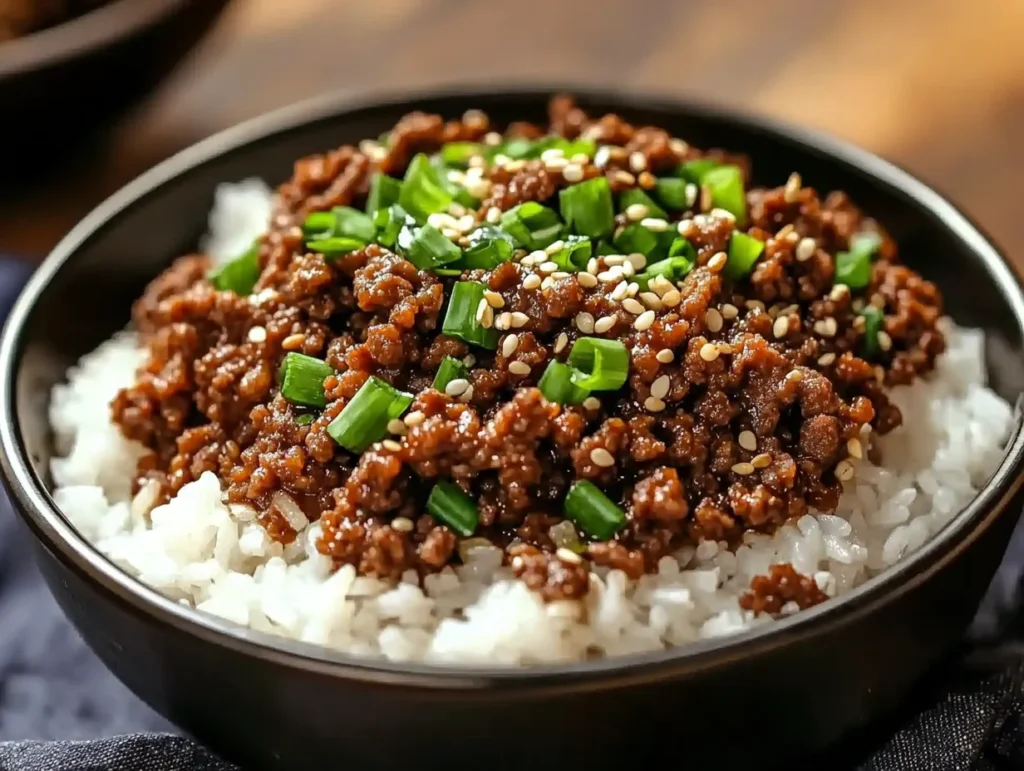
Ground Beef
The foundation of our dish is lean ground beef, preferably 93% lean. This balanced fat content provides enough richness without making the dish greasy. The fine texture of ground beef allows it to quickly absorb the flavorful sauce, making it ideal for this fast-cooking recipe.
The Aromatic Base
Garlic and ginger form the aromatic foundation of many Asian dishes, and this Korean beef bowl is no exception. Fresh ingredients make a significant difference here – the sharp, pungent notes of freshly minced garlic and the warm, spicy undertones of grated ginger infuse the beef with quintessential Korean flavors.
The Signature Sauce
The sauce is where this dish truly becomes Korean-inspired. Low-sodium soy sauce provides the salty umami base, while brown sugar balances it with subtle sweetness. Sesame oil adds a distinctive nutty flavor that’s unmistakably Asian. The red pepper flakes bring a gentle heat that can be adjusted based on your spice preference.
Fresh Elements
Green onions add brightness and a mild onion flavor without overpowering the dish. Using both the white and green parts efficiently utilizes the entire ingredient – the whites are cooked with the beef for depth, while the greens are added at the end for freshness and color.
The Rice Foundation
Rice serves as the perfect canvas for the flavorful beef. Whether you choose traditional white rice for authenticity or brown rice for added nutrition, it helps balance the bold flavors of the meat and provides satisfying substance to the meal.
Colorful Vegetables
The fresh vegetables aren’t merely garnish – they add contrasting textures, nutritional value, and visual appeal. Cucumber provides refreshing crunch, carrots add sweetness and color, while mixed greens or cabbage contribute pleasant bitterness and additional texture.
How to Make Korean Ground Beef Bowl – Step by Step
Step 1: Prepare the Sauce
In a small bowl, whisk together the soy sauce, brown sugar, sesame oil, rice vinegar (if using), black pepper, and red pepper flakes until the sugar is completely dissolved. The sauce should have a balanced sweet-savory profile with a hint of heat. Set aside to allow the flavors to meld while you prepare the other components.
Step 2: Prepare Your Mise en Place
Before heating your pan, ensure all ingredients are prepped and ready: mince the garlic, grate the ginger, slice the green onions (separating white and green parts), and prepare any vegetables for serving. Having everything ready will make the cooking process smooth and efficient, especially since this dish comes together quickly.
Step 3: Cook the Beef
Heat a large skillet or wok over medium-high heat. Add the vegetable oil and allow it to heat until shimmering. Add the ground beef and cook, breaking it into small crumbles with a wooden spoon. Resist the urge to stir constantly – allowing the meat to develop some caramelization on the bottom will enhance the flavor complexity. When the beef is about halfway cooked (still slightly pink), add the minced garlic, grated ginger, and white parts of the green onions.
Step 4: Season and Reduce the Sauce
Once the beef is almost completely browned (about 5-6 minutes total cooking time), pour the prepared sauce over the meat. Stir well to combine, making sure every piece of beef is coated with the flavorful sauce. Reduce the heat to medium and let it simmer for 2-3 minutes until the sauce thickens slightly and coats the beef evenly. The reduction process concentrates the flavors and creates a glossy finish that will cling beautifully to the meat.
Step 5: Finish the Beef Mixture
Stir in two-thirds of the green parts of the green onions, reserving the remainder for garnish. Allow the mixture to cook for another 30 seconds to slightly wilt the green onions while maintaining their bright color. Taste and adjust seasonings if necessary – you may want to add a touch more soy sauce for saltiness or brown sugar for sweetness, depending on your preference. Remove from heat once you’re satisfied with the flavor balance.
Step 6: Cook the Rice (If Not Already Prepared)
If you haven’t already prepared your rice, now is the time. For white rice, rinse thoroughly until the water runs clear, then cook according to package instructions (typically 1 cup rice to 1.5 cups water, brought to a boil, then simmered covered for 15-18 minutes). For brown rice, the ratio is usually 1 cup rice to 2 cups water, with a longer cooking time of 35-40 minutes. If using a rice cooker, simply follow the appliance instructions.
Step 7: Prepare Fresh Components
While the rice cooks, prepare your fresh components if you haven’t already. Thinly slice the cucumber, julienne or grate the carrots, wash and dry the mixed greens or shred the cabbage, and slice the avocado if using. Arrange these items on a platter for easy assembly, or set them out buffet-style to allow diners to customize their bowls.
Step 8: Assemble the Bowls
Divide the cooked rice among serving bowls, creating a base layer. Top with a generous portion of the Korean beef mixture in the center. Artfully arrange the cucumber slices, carrots, mixed greens or cabbage, and avocado (if using) around the beef, creating a colorful presentation. Sprinkle with sesame seeds and the remaining sliced green onions for a professional finishing touch.
Step 9: Final Touches (Optional)
For those who enjoy extra heat, offer a small dish of gochujang sauce (Korean chili paste) on the side. A small portion of kimchi can also be added for authentic Korean flavor and probiotic benefits. These optional additions allow diners to customize the spice level and complexity of their bowls according to personal preference.
Pro Tips for Making the Best Korean Ground Beef Bowl
Expert Techniques for Maximum Flavor
- Toast your sesame seeds in a dry pan for 1-2 minutes until golden to enhance their nutty flavor. Watch carefully as they can burn quickly.
- Don’t overcook the beef – keeping it slightly juicy will make for a more flavorful final dish. Aim for tender, not dry.
- Add the garlic and ginger partway through cooking the beef to prevent burning while still allowing their flavors to develop and infuse the meat.
- Meal prep option: Make a double batch of the beef and store in portions for quick meals throughout the week. The flavor actually improves after a day in the refrigerator.
- Use freshly grated ginger rather than powder for the best flavor impact. Pro tip: Keep ginger root in the freezer and grate while frozen for easy use.
- Let the sauce simmer briefly to thicken and coat the beef properly. This concentration of flavors is key to the dish’s success.
- Balance is key in the sauce – taste and adjust the sweet, salty, and spicy elements to suit your preference before adding to the beef.
- Cook in a cast iron skillet if you have one for better caramelization and flavor development.
- Allow the beef to brown before stirring too much – this develops the rich umami flavors that make this dish special.
Ingredient Substitutions and Adaptations
For those with dietary restrictions or ingredient limitations, this Korean beef bowl recipe remains accessible with these clever substitutions:
- Coconut aminos can replace soy sauce for a gluten-free, lower sodium alternative that maintains the umami flavor profile.
- Honey or maple syrup can substitute for brown sugar if preferred, though the flavor will be slightly different.
- Ground turkey or chicken works wonderfully for those reducing red meat consumption – just add 1 tablespoon of oil to compensate for the lower fat content.
- Fresh minced garlic can be replaced with 1 teaspoon of garlic powder in a pinch (though fresh is preferred).
- Ground ginger (1/2 teaspoon) can substitute for fresh, but add it directly to the sauce rather than to the cooking beef.
- Rice vinegar can be replaced with apple cider vinegar if unavailable.
- Cauliflower rice makes an excellent low-carb base for those watching carbohydrate intake.
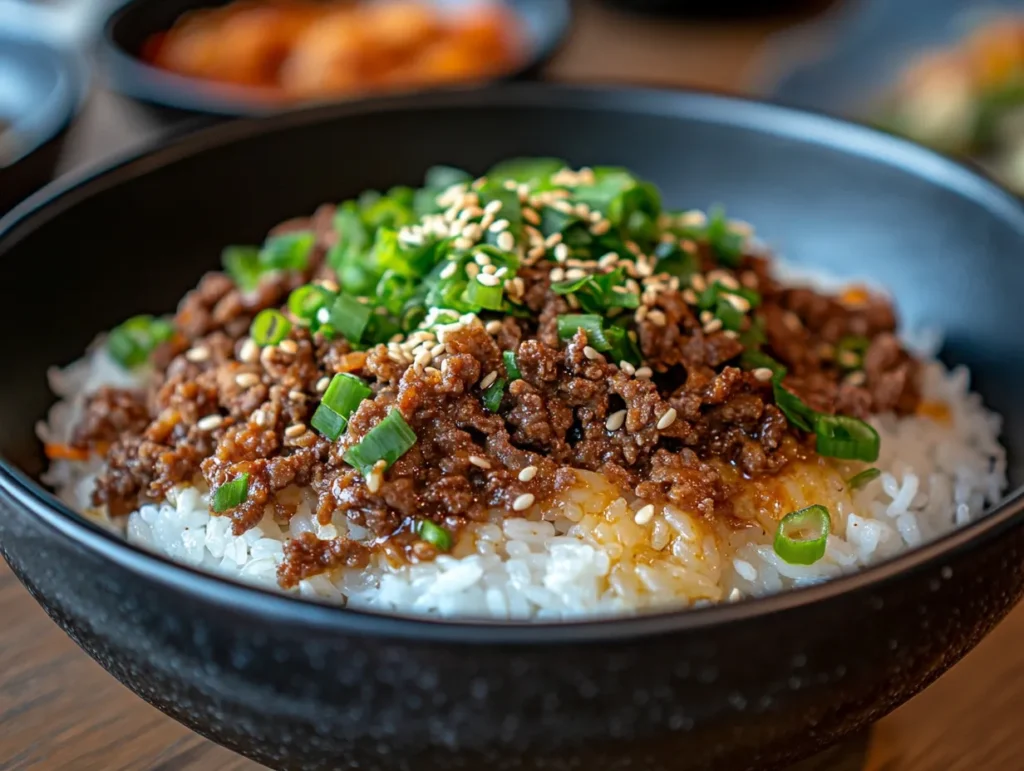
Enhancing the Basic Recipe
Once you’ve mastered the basic version, consider these enhancements to elevate your Korean beef bowl even further:
- Add sautéed mushrooms to the beef for extra umami depth and nutritional benefits.
- Include diced bell peppers for color, sweetness, and vitamin C – add them with the garlic and ginger.
- Try gochujang paste (1-2 teaspoons) in the sauce for authentic Korean flavor and a more complex heat.
- Mix in baby spinach at the end until just wilted for added nutrition and color.
- Drizzle with sriracha mayo (mix sriracha and mayonnaise) for a creamy, spicy finish that contrasts beautifully with the beef.
- Incorporate kimchi on the side for probiotics and authentic Korean accompaniment.
- Top with a fried egg with a runny yolk to add richness that coats the rice when broken.
Best Ways to Serve Korean Ground Beef Bowl
Creative Serving Options
This versatile dish can be served in multiple ways to suit various preferences and dietary needs:
- Traditional rice bowl – with white or brown rice as the base for an authentic experience
- Low-carb option – serve over cauliflower rice or with extra vegetables for those monitoring carbohydrate intake
- Lettuce wraps – use large butter lettuce or romaine leaves instead of rice for a lighter, refreshing meal with interesting texture contrast
- Meal prep containers – portion rice, beef, and vegetables in compartmentalized containers for easy grab-and-go lunches throughout the week
- Bibimbap style – arrange components in sections over rice and mix at the table for an interactive dining experience
- Burrito filling – use as a filling in large flour tortillas with rice and vegetables for a Korean-Mexican fusion
- Noodle bowl – serve over cooked soba, udon, or rice noodles instead of rice for a different textural experience
- Protein-focused plate – double the protein and serve with a small portion of rice and extra vegetables for higher protein needs
- Family style – present all components in separate dishes at the table, allowing diners to build their own custom bowls
Perfect Accompaniments and Side Dishes
Enhance your Korean ground beef bowl with these complementary side dishes and condiments:
Traditional Korean Sides
- Kimchi – offers probiotic benefits and authentic Korean flavor
- Quick-pickled vegetables – provide acidic contrast and crunch
- Korean spinach (Sigeumchi Namul) – seasoned with sesame and garlic
- Bean sprout salad (Sookju Namul) – light and refreshing with subtle seasoning
Fresh Additions
- Simple side salad with rice vinegar dressing
- Sliced avocado for creamy richness
- Shredded daikon radish for peppery crunch
- Soft-boiled eggs with jammy yolks
Sauces and Condiments
- Gochujang sauce (Korean chili paste thinned with a bit of water and sesame oil)
- Sriracha for those who enjoy extra heat
- Sesame dressing drizzled over the vegetables
- Quick cucumber pickle with rice vinegar, sugar, and salt
Beverage Pairings
- Barley tea (traditional Korean beverage)
- Cold light beer to contrast with the umami flavors
- Slightly sweet white wine like Riesling
- Sparkling water with lime for a refreshing non-alcoholic option
The beauty of this dish lies in its adaptability – it can be as simple or elaborate as you desire, making it perfect for everything from quick weeknight dinners to impressive casual entertaining.
Nutritional Information for Korean Ground Beef Bowl
Complete Nutritional Profile
- Calories: 450 kcal per serving
- Protein: 28g
- Carbohydrates: 42g
- Fat: 18g
- Fiber: 4g
- Sugar: 12g
- Sodium: 650mg
- Potassium: 520mg
- Iron: 15% DV
- Calcium: 6% DV
- Vitamin A: 45% DV
- Vitamin C: 35% DV
Note: Nutritional values may vary depending on specific ingredients used and serving sizes. The values above are calculated based on using 93% lean ground beef, brown rice, and the recommended vegetables.
Health Benefits of Key Ingredients
This Korean Ground Beef Bowl isn’t just delicious—it’s also packed with nutritional benefits:
Ground Beef
A excellent source of high-quality protein, which is essential for muscle maintenance and growth. Beef also provides important nutrients like iron in a highly absorbable form, helping to prevent anemia and support energy levels. Additionally, beef contains zinc for immune function and B vitamins for energy metabolism.
Fresh Vegetables
The combination of cucumbers, carrots, and mixed greens provides a wealth of vitamins, minerals, and antioxidants. These plant foods are low in calories but high in fiber, supporting digestive health and helping you feel satisfied for longer.
Brown Rice (if used)
Offers more fiber and nutrients than white rice, including magnesium for muscle function and B vitamins for energy. The complex carbohydrates provide sustained energy release rather than a quick spike and crash.
Garlic and Ginger
Both have been used medicinally for centuries and contain compounds with anti-inflammatory and antioxidant properties. Garlic may support heart health, while ginger can aid digestion and reduce nausea.
Sesame Seeds
Though small, these seeds pack a nutritional punch with calcium, iron, magnesium, and zinc. They also contain lignans, which may have cholesterol-lowering effects.
Dietary Adaptations
This recipe can be modified to suit various dietary needs while maintaining its nutritional value:
- Lower Carb Version: Substitute cauliflower rice for regular rice to reduce carbohydrates to approximately 15g per serving.
- Higher Protein Option: Increase ground beef to 1.5 pounds to boost protein to approximately 35g per serving.
- Lower Sodium Alternative: Reduce soy sauce to 2 tablespoons and use sodium-free seasonings to bring sodium down to approximately 450mg per serving.
- Higher Fiber Variation: Add 1/2 cup edamame and use brown rice to increase fiber to approximately 7g per serving.
Storage & Leftovers
Proper Food Safety and Storage Guidelines
- Refrigerator: Store leftover beef mixture in an airtight container for up to 3 days. Make sure to cool the beef completely before refrigerating to prevent bacterial growth and maintain food safety.
- Freezer: The beef mixture freezes well for up to 3 months. Portion into individual serving sizes in freezer-safe containers or bags for convenient future meals. Label with the date to keep track of freshness. Thaw overnight in the refrigerator before reheating.
- Reheating: Warm in a microwave at 70% power for 1-2 minutes, stirring halfway through, or in a skillet over medium heat with a splash of water or beef broth to prevent drying out. Always ensure the internal temperature reaches 165°F (74°C) for food safety.
- Meal prep: Store components separately for best quality, assembling just before eating. Keep rice in a separate container from the beef and vegetables to maintain optimal texture for each component.
Maximizing Leftover Quality
The Korean beef component of this recipe often tastes even better the next day as the flavors have time to meld and develop. Here are some tips for making the most of your leftovers:
- Refresh with additions: When reheating the beef, add a splash of soy sauce or a few drops of sesame oil to rejuvenate the flavors.
- New rice: While the beef reheats beautifully, rice tends to dry out. Consider making fresh rice when serving leftovers, or add a tablespoon of water to rice before reheating to restore moisture.
- Fresh garnishes: Even when using leftover beef and rice, add freshly sliced green onions, sesame seeds, and vegetables just before serving to provide textural contrast and fresh flavor.
- Alternative presentations: Transform leftovers into a completely different meal by using the beef mixture in:
- Fried rice with egg and vegetables
- Stuffed bell peppers with rice and cheese
- Korean-inspired quesadillas with cheese and kimchi
- Lettuce wraps for a lighter lunch option
Make-Ahead Strategies for Meal Planning
This Korean ground beef bowl is an excellent candidate for strategic meal planning. Here’s how to leverage this recipe for efficient weekly prep:
- Sunday prep session: Double or triple the beef mixture and cook several cups of rice. Portion into individual containers with separate compartments for vegetables.
- Freezer packets: Prepare the raw beef mixture (without cooking) and freeze flat in zip-top bags. Thaw overnight when needed for an almost-instant dinner – just cook and serve with freshly made sides.
- Sauce preparation: Make a large batch of the sauce and keep in a jar in the refrigerator for up to 1 week. Use a few tablespoons to quickly flavor any ground meat for an impromptu Asian-inspired meal.
- Vegetable prep: Slice cucumbers, carrots, and other sturdy vegetables in advance and store in water-filled containers in the refrigerator to maintain crispness throughout the week.
FAQs for Korean Ground Beef Bowl
Can I make Korean Ground Beef Bowl ahead of time?
Yes! The Korean Ground Beef Bowl can be made 1-2 days ahead and stored in the refrigerator. It actually tastes even better the next day as the flavors have time to meld. For best results, store the components separately and assemble just before serving. The beef mixture can be reheated in a microwave or skillet while you prepare fresh rice or reheat pre-cooked rice separately.
What can I use instead of ground beef in Korean Ground Beef Bowl?
Ground turkey, chicken, or pork all work well as substitutes in this Korean Ground Beef Bowl recipe. For a vegetarian option, try crumbled tofu or a plant-based ground meat alternative with the same seasonings. If using leaner meats like ground turkey breast, add an extra tablespoon of oil to maintain moisture and prevent the meat from becoming dry.
Is Korean Ground Beef Bowl spicy?
The Korean Ground Beef Bowl recipe as written has a mild heat from the red pepper flakes. You can adjust the spice level by increasing or decreasing the amount of red pepper flakes, or by adding gochujang (Korean chili paste) for more authentic Korean flavor. For a completely non-spicy version, omit the red pepper flakes entirely and use black pepper for seasoning instead.
Can I freeze Korean Ground Beef Bowl?
The beef mixture for Korean Ground Beef Bowl freezes excellently for up to 3 months. Store in airtight containers or freezer bags. Thaw overnight in the refrigerator before reheating. It’s best to prepare fresh rice and vegetables when ready to serve. Label your frozen portions with the date and contents for easy meal planning.
What makes Korean Ground Beef Bowl different from regular beef bowls?
The Korean Ground Beef Bowl gets its distinctive flavor from the combination of soy sauce, brown sugar, sesame oil, and ginger – key ingredients in Korean cuisine. Traditional Korean beef dishes often use these flavors in marinades for thinly sliced beef (bulgogi), but this ground beef version offers the same delicious taste in a more convenient, faster-cooking format that’s perfect for quick meals.
How can I make my Korean Ground Beef Bowl more authentic?
To make your Korean Ground Beef Bowl more authentic, consider adding gochujang (Korean chili paste) to the sauce, serving with traditional banchan (side dishes) like kimchi, using short-grain rice instead of long-grain, and incorporating more traditional Korean vegetables like spinach seasoned with sesame oil and garlic. A fried egg on top is also a common addition in Korean rice bowls. If using leaner meats like ground turkey breast
Related Recipes You’ll Love
If you enjoy this Korean Ground Beef Bowl, try these other 5 quick and flavorful recipes:
- 15-Minute Honey Garlic Chicken Stir Fry
- 20-Minute Easy Beef and Broccoli
- 25-Minute Thai Basil Chicken Bowl
- 30-Minute Teriyaki Salmon Rice Bowls
- 15-Minute Quick Vegetable Bibimbap
The Korean Ground Beef Bowl recipe shares many characteristics with these dishes – they’re all designed for busy home cooks who don’t want to sacrifice flavor for convenience. Each recipe uses similar cooking techniques and several overlapping ingredients, making it easy to expand your weeknight dinner rotation once you’ve mastered your first Korean Ground Beef Bowl.
Conclusion
This delicious Korean Ground Beef Bowl is proof that incredible flavor doesn’t have to be complicated or time-consuming. With its perfect balance of sweet, savory, and slightly spicy flavors, this 20-minute meal will quickly become a staple in your dinner rotation. It’s versatile enough to please everyone at your table while being simple enough for even novice cooks to master.
The humble Korean Ground Beef Bowl demonstrates how a few quality ingredients and simple techniques can transform an ordinary package of ground beef into something extraordinary. By mastering this recipe, you’re adding not just a dish but a cooking strategy to your repertoire – one that will serve you well on those busy evenings when time is short but you still want to enjoy a homemade meal.
Next time you’re tempted to order takeout, remember this quick and satisfying Korean Ground Beef Bowl instead! It’s faster than delivery, more affordable, and you’ll feel great knowing exactly what went into your meal.
Have you tried this Korean Ground Beef Bowl recipe? Let us know in the comments how it turned out and any creative variations you tried with your Korean Ground Beef Bowl!
Print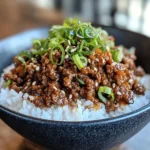
10 Best Korean Ground Beef Bowl Recipe Tips – Quick & Easy 30-Minute Meal
- Total Time: 20 minutes
- Yield: 4 servings 1x
- Diet: Gluten Free
Description
This delicious Korean Ground Beef Bowl is ready in just 20 minutes! Featuring savory-sweet ground beef seasoned with ginger, garlic, and sesame oil, served over fluffy rice with fresh vegetables. Perfect for busy weeknights when you need a quick but flavorful meal.
Ingredients
- 1 pound lean ground beef (93% lean recommended)
- 3 cloves garlic, minced
- 1 tablespoon fresh ginger, grated
- 1/4 cup low-sodium soy sauce
- 3 tablespoons brown sugar
- 1 tablespoon sesame oil
- 1/2 teaspoon red pepper flakes (adjust to taste)
- 3 green onions, sliced (white and green parts separated)
- 1 tablespoon vegetable oil (for cooking)
- 1 teaspoon rice vinegar (optional, for brightness)
- 1/4 teaspoon black pepper
- 3 cups cooked rice (white or brown)
- 1 cucumber, thinly sliced
- 1 carrot, julienned or grated
- 1 cup mixed greens or shredded cabbage
- 1 avocado, sliced (optional)
- Sesame seeds for garnish
- Kimchi (optional, for authentic Korean flavor)
- Gochujang sauce (optional, for extra spice)
Instructions
- In a small bowl, whisk together the soy sauce, brown sugar, sesame oil, rice vinegar (if using), black pepper, and red pepper flakes until the sugar is completely dissolved.
- Prepare all ingredients: mince the garlic, grate the ginger, slice the green onions (separating white and green parts), and prepare vegetables for serving.
- Heat a large skillet over medium-high heat. Add the vegetable oil and allow it to heat until shimmering.
- Add the ground beef to the hot pan and cook, breaking it into small crumbles with a wooden spoon. Allow some caramelization to develop for better flavor.
- When the beef is about halfway cooked (still slightly pink), add the minced garlic, grated ginger, and white parts of the green onions.
- Once the beef is almost completely browned (about 5-6 minutes total cooking time), pour the prepared sauce over the meat.
- Stir well to combine, making sure every piece of beef is coated. Reduce the heat to medium and let it simmer for 2-3 minutes until the sauce thickens slightly.
- Stir in two-thirds of the green parts of the green onions, reserving the remainder for garnish.
- Divide the cooked rice among serving bowls, creating a base layer.
- Top with a generous portion of the Korean beef mixture in the center.
- Arrange the cucumber slices, carrots, mixed greens or cabbage, and avocado (if using) around the beef.
- Sprinkle with sesame seeds and the remaining sliced green onions.
- Serve with kimchi or gochujang sauce on the side if desired.
Notes
- Toast your sesame seeds in a dry pan for 1-2 minutes until golden to enhance their nutty flavor.
- Don’t overcook the beef – keeping it slightly juicy will make for a more flavorful final dish.
- For meal prep, make a double batch of the beef and store in portions for quick meals throughout the week.
- Use freshly grated ginger rather than powder for the best flavor impact. Pro tip: Keep ginger root in the freezer and grate while frozen for easy use.
- For a low-carb option, serve over cauliflower rice instead of regular rice.
- Add a fried egg with a runny yolk on top for extra richness and protein.
- For a spicier version, add 1-2 teaspoons of gochujang paste to the sauce.
- Prep Time: 10 minutes
- Cook Time: 10 minutes
- Category: Main Dish
- Method: Stovetop
- Cuisine: Korean-Inspired
Nutrition
- Serving Size: 1 bowl
- Calories: 450 kcal
- Sugar: 12g
- Sodium: 650mg
- Fat: 18g
- Saturated Fat: 5g
- Unsaturated Fat: 11g
- Trans Fat: 0g
- Carbohydrates: 42g
- Fiber: 4g
- Protein: 28g
- Cholesterol: 70mg
Keywords: Korean ground beef bowl, quick dinner, Asian beef recipe, easy Korean beef, weeknight meal, ground beef recipe, Korean rice bowl, 20-minute dinner, beef bowl, Korean beef

